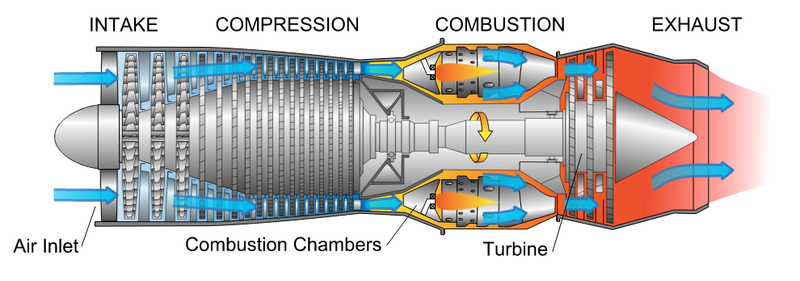Specific power
Specific power or power-to-weight ratio is a measure of performance for an engine in a vehicle or in a power plant. It is defined as the power output by it divided by its mass,[1] typically in units of W/kg or hp/lb. This value allows for a clear metric of the power that is independent of the vehicle or power plant's size:
Turbines, like a gas turbine in a plane, typically have the largest specific power for an engine. This makes them useful for airplanes in order to achieve sufficient lift, like in Figure 1. Sports car engines will also typically have a fairly high specific power, allowing them to have increased acceleration and handling.
Some examples:[2]
| Engine Type | Power (W) / Mass (kg) | Specific Power (W/kg) |
|---|---|---|
| Automobile engine | 149140 / 168 | 888 |
| Indycar Engine | 596560 / 125 | 4772 |
| Jet Engine | 39447523 / 1270.059 | 31061 |
| Space Shuttle Main Engine Fuel Turbopump |
53690391 / 352 | 152530 |

Figure 1. A diagram of a gas turbine engine. Aircraft gas turbines have the very large specific powers because they're designed to be light for their given power.[3]
For Further Reading
- Engine
- Power
- Turbine
- Acceleration
- Horsepower
- Or explore a random page
References
- ↑ OED in entry on specific (July 8, 2015) it says (in definition d): d. Physics. Of or designating a dimensionless number equal to the ratio of the value of a property of a given substance to the value of the same property of some reference substance (as water) or of vacuum under the same conditions, so providing a relative value for comparison with different substances, as specific gravity (see gravity n. 4c); specific heat (see heat n. 2d); specific inductive capacity = dielectric constant n. at dielectric adj. 2b; specific viscosity, the difference between the viscosity of a solution of a given concentration and that of the pure solvent, divided by the viscosity of the pure solvent. The energy education team has interpreted this to include specific power. This term has been used in places online.
- ↑ R. Ryan, NASA. (July 8, 2015). Lessons in Systems Engineering - The SSME Weight Growth History [Online], Available: http://ntrs.nasa.gov/archive/nasa/casi.ntrs.nasa.gov/20090004620.pdf
- ↑ Wikimedia Commons [Online], Available: https://upload.wikimedia.org/wikipedia/commons/4/4c/Jet_engine.svg

